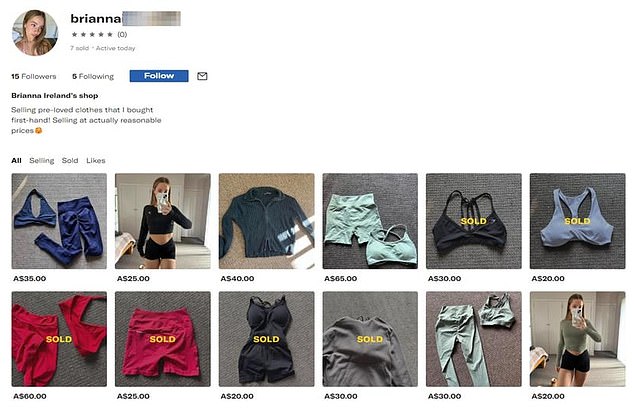Brianna was excited after thinking she’d done a deal to sell pre-loved clothes. Moments later she realised $4,000 had been stolen in a sophisticated scam
A nursing student has revealed how someone posing as a buyer at a second-hand clothing store was able to steal $4,000 through a sophisticated online scam.
Brianna Ireland wanted to sell her spare tops, bottoms and gym clothes to make some money after recently moving to university and decided to list them on Depop – a popular online marketplace for second-hand clothes.
The 19-year-old said she liked the eco-friendly idea of passing on the items and was contacted by her first buyer in early May, not long after setting up her page, and although she was still unfamiliar with how the process worked .
The buyer, known as Sarah, messaged Brianna and told her to include her email address on her Depop profile page under the “my website” field because the site’s checkout was asking for that information.
“I was so excited to sell clothes, I just didn’t think anything of it… I was so caught up in the moment,” Brianna said 7Life.
Student Brianna Ireland listed some second-hand clothes on Depop, but a hacker posing as a buyer scammed her

Depop said the ‘buyer’ hacked into a real user’s account and then emailed Ms Ireland a fake sales verification form
The ‘buyer’ then told her to wait for a confirmation email in her inbox to greenlight the sale.
The email appeared shortly afterwards and contained a link to ‘verify purchase’, which took Ms Ireland to what appeared to be a ‘legitimate’ Depop site with the customer’s details including the shipping address, their email address and phone number.
The website asked her to add her bank details so she could get paid.
Ms Ireland said at this point that she should have noticed the ‘red flag’ as she had already entered her PayPal details with Depop, but dismissed it, thinking that ‘maybe my PayPal account for some reason wouldn’t have worked’.
She said that after entering her bank details the website seemed to freeze and then told her an error had occurred and a chatbot appeared asking if she had another bank account to try.
“At the time I was extremely confused as to why it was asking me this, and that’s when it hit me.”
A panicked Ms Ireland checked her bank account and saw that a withdrawal of $529.22 had just been made to ‘Bitinvestor’, based in Denmark.
She immediately called her bank and was on hold for five minutes, during which the scammer tried to withdraw money again.
By the time Ms Ireland spoke to an employee, who quickly froze her account, she was in tears.
Another $3,500 had been withdrawn.


The nursing student said she dismissed red flags like bad grammar as laziness, but the experience wouldn’t stop her from using the site again
But there was good news: the employee told her because they received the second payment so quickly that they were able to cancel the transaction.
The initial payment of $529 had already been processed and could not be returned.
“I’m so thankful I called the bank when I did, otherwise the payment wouldn’t have been returned to my account and they would have definitely emptied my entire bank account,” she said.
After reporting the scam to Depop, Ms Ireland said they told her the scammer had hacked into someone else’s real account to pose as the buyer.
In retrospect, the full-time student said there were other indicators she should have noticed, such as the poor grammar, which she assumed was just laziness, and the domain from which the sales verification email was sent, which she did not properly check.
She said she learned her lesson and still uses Depop, but is much more careful about the process when using the site and talking to buyers.
A spokesperson for Depop said the site has extensive safeguards in place to block scams and fraudulent behavior.
‘Our in-app payment systems are specifically designed to keep users safe, and legitimate payments on Depop will only be made within the app or Depop.com.
“Unfortunately, as peer-to-peer marketplaces become more popular, scammers are using increasingly sophisticated methods to encourage consumers to pay outside secure platforms. This is a problem that affects the entire sector.’
‘We strongly encourage consumers who buy and sell anywhere online to never share personal information with other users, to be very careful when following links to other sites, and to report any suspicious behavior.’
The company recommends only using the genuine Depop app or website to communicate with buyers or enter information.
The real site is depop.com and real emails will come from the @depop.com domain, the company said.
Daily Mail Australia has contacted Depop for further comment.
